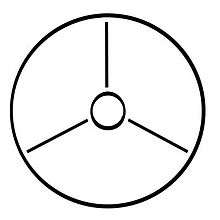Mukden Arsenal Mauser
| Mukden Arsenal Mauser | |
|---|---|
| Type | Rifle |
| Place of origin | Manchukuo |
| Service history | |
| Used by | Manchukuo Imperial Army |
| Wars | World War Two |
| Production history | |
| Designer | Mukden Arsenal |
| Designed | 1933 |
| Manufacturer | Mukden Arsenal |
| Produced | 1933-1938 |
| No. built | c. 13,000 |
| Specifications | |
| Weight | 9.4 pounds (4.3 kg) |
| Length | 48.82 inches (124.0 cm) |
| Barrel length | 29.13 inches (740 mm) |
|
| |
| Cartridge | 7.92x57mm, 6.5x50mm |
| Action | Bolt action |
| Feed system | 5-round, staggered column, flush, box internal magazine |
| Sights | Tangent leaf rear sight graduated to 2,000 metres (6,600 ft) |
The Mukden Arsenal Mauser was a rifle that implemented characteristics of both the Mauser Model 1898 and the Arisaka rifles.[1][2][3] They were mostly built in the Mukden arsenal in Manchukuo.[2][4]
Design detail
Arisaka characteristics
The rifle shared many features with the Arisaka rifle, such as a two-part stock, a ovoid bolt handle, and double-gas escape ports on the receiver. It also had a sliding bolt cover that attached to the bolt, and was removable. Another similarity it had with the Arisaka was the bolt being bored from the rear, in order to allow room for a mainspring, which was fixed in by the use of a large housing.[2]
Mauser characteristics
The rifle's safety is similar to that of the Mauser 1898; however, instead of being threaded, the bolt sleeve is fixed to the bolt by way of lugs. The rifle has a pistol grip stock, but with no grasping grooves. Its upper handguard runs from the receiver ring to the lower band. The upper and lower bands are both thinner than on a Mauser, and there is a parade hook for the upper band. The nose cap of the rifle has a short H bayonet lug, so only a bayonet with a muzzle ring can be fitted to it. The lower barrel band has a swivel, and there is a quick-release sling fitting behind the stock's pistol grip.[2]
Specifications

The rifle was built to be 48.82 inches (124.0 cm) long, with the barrel making up 29.13 inches (740 mm) of that, to weigh 9.4 pounds (4.3 kg). It was designed to be a bolt action rifle with a 5-round box magazine, and have a tangent leaf rear sight that was graduated to 2,000 metres (6,600 ft). It was made mostly to fire 7.92x57mm (Mauser) bullets, however some were modified to hold 6.5x50mm (Arisaka) bullets,[1][2][4] those that were modified to fire 6.5x50mm bullets were given an auxiliary block in the back of the magazine well in order to compensate for the size difference of the cartridges.[5] The rifle had a left handed 4-groove rifling. The top of the receiver ring was marked with the symbol of the Mukden arsenal, and the serial number of the gun was placed on the left side of the receiver ring.[2]
History
In 1938 the Mukden arsenal was re-fitted to produce Arisaka 99s, likely ending the production of the Mukden Arsenal Mauser entirely.[5]
References
- 1 2 Peterson, Phillip (2011). Standard Catalog of Military Firearms the Collector's Price and Reference Guide (6th ed.). Iola, Wis.: F+W Media. p. 256. ISBN 9781440228810.
- 1 2 3 4 5 6 Ball, Robert W.D. (2006). Mauser military rifles of the world (4th ed.). Iola, WI: Gun Digest Books. pp. 242–243. ISBN 9781440226830.
- ↑ "Rock Island Auction: Mukden - Mauser". www.rockislandauction.com. Retrieved 15 December 2016.
- 1 2 "NRA Museums:". www.nramuseum.org. Retrieved 15 December 2016.
- 1 2 Walter, John (2006). Rifles of the world (3. ed.). Iola, Wis.: Krause. p. 321. ISBN 9780896892415.